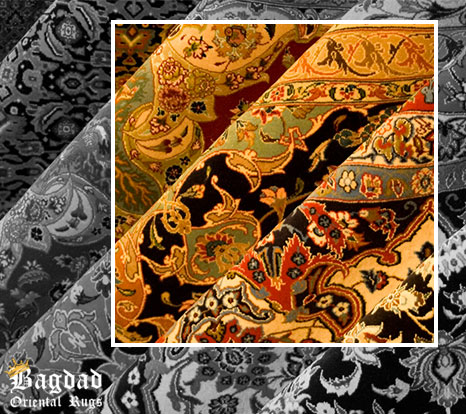This article is designed to help those affected by flood who want advice on restoring rug colors after they’ve been damaged by floodwaters. First and foremost, we want to extend our sympathies for your loss, and wish you a full and speedy recovery. The devastation caused by the recent storm uprooted many families and resulted in the loss of many items of personal value, including your rugs.
We understand how losing a rug that’s been in your family for many years can be distressing. Water damaged rugs are often stained or warped in some way, and many often exhibit fading or bleeding colors as a result of prolonged water exposure. On top of everything else, they usually don’t smell or feel too good either due to the possible presence of mold or mildew.
Fortunately, many water damaged rugs can be restored, depending on their age, origin and material, despite being submerged in floodwater for days and even weeks. In particular, Persian and Oriental rugs are fairly water resistant. Rugs made of natural fibers like wood and silk are well known for their ability to sustain water damage. With that said, don’t be surprised if your rug’s colors show signs of fading or bleeding. Also, be prepared for the rug’s cotton foundation to possibly become warped or rotted due to floodwater damage.
With that in mind, this article will cover two key topics: 1) what to do in the immediate aftermath to preserve a water damaged rug and 2) what professionals can do to do to restore your rug.

Saving Your Rug After a Flood
As soon as it’s possible to do so, you want to take immediate action to preserve your rug. Failure to do so can result in irreversible rug discoloration.
The first and most important step is to hose down your rug with clean running water. This part may seem counterintuitive at first: after all, isn’t your rug already wet from the hurricane floodwaters? The reason you want to douse your rug with water is to wash away dirt and debris that collected in the rug’s fibers during the storm. It also removes bacteria and particulates that could be harmful if inhaled. For this reason, you want to make sure you and anyone else handling the rug is wearing the proper safety equipment, including latex rubber gloves and a safety mask covering both the nose and mouth.
Once you’ve hosed off your rug, the next step is to dry out your rug as much as possible. This will allow the rug’s foundation to recover and will also make it easier to transport the rug since they’re typically heavier to move when wet. Laying your rug out in the sun might be the best rug drying method, as it’ll help to kill mold and restore the rug’s natural oils. Another option is renting a wet-dry vacuum or a dehumidifier and drying the rug out that way. If you’re not sure which method is best, consult with a rug care expert.
Professional Rug Color Restoration
Once you’ve completed the first phase of the process, your next move should be to contact a rug restoration expert immediately. A rug care professional can best assess the steps necessary to treat your particular rug. This is important because different kinds of rugs require their own unique methods for treating them. In addition, rug restoration experts utilize a higher grade of cleaning equipment to treat rugs, including chemical and enzyme free soaps and industrial grade rug washing and rug dry cleaning equipment.
Another reason to make an appointment with a rug restoration expert is that he or she can appraise the state of your rug. The appraiser can assess, among other things, the financial value of your rug, its natural colors and the extent of the flooding damage. Having your rug appraised by a professional will make it easier for you to collect damages from your insurance company. It’s also a good idea to take plenty of photos of your water damaged rug so you can provide evidence of flooding for insurance agents.
Finally, if the rug is replaceable, then you may want to consider doing so. We understand that you may have developed a sentimental attachment to your rug. But when it comes to the flooding brought about by Harvey, it’s not just water that your rug absorbed, but chemicals and sewage that can be unhealthy to members of your household. Cheaply made or mass produced rugs may not be worth the cost to have them professionally restored. If it’s an antique or expensive rug, you may already have taken out an insurance policy to protect it from flooding. If not, we suggest seeking compensation from your home insurance provider.
We hope you found this article helpful and we wish you the best of luck in restoring your flooded rug. For more information, contact one of our rug restoration professionals at (713) 783-3500.

